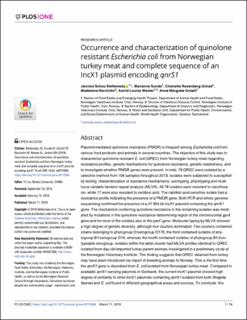| dc.contributor.author | Slettemeås, Jannice Schau | |
| dc.contributor.author | Sunde, Marianne | |
| dc.contributor.author | Ulstad, Charlotte Rosenberg | |
| dc.contributor.author | Norström, Madelaine | |
| dc.contributor.author | Wester, Astrid Louise | |
| dc.contributor.author | Urdahl, Anne Margrete | |
| dc.date.accessioned | 2022-08-12T06:38:00Z | |
| dc.date.available | 2022-08-12T06:38:00Z | |
| dc.date.created | 2019-03-29T14:50:44Z | |
| dc.date.issued | 2019 | |
| dc.identifier.issn | 1932-6203 | |
| dc.identifier.uri | https://hdl.handle.net/11250/3011478 | |
| dc.description.abstract | Plasmid-mediated quinolone resistance (PMQR) is frequent among Escherichia coli from various food products and animals in several countries. The objective of this study was to characterize quinolone resistant E. coli (QREC) from Norwegian turkey meat regarding resistance profiles, genetic mechanisms for quinolone resistance, genetic relatedness, and to investigate whether PMQR genes were present. In total, 78 QREC were isolated by a selective method from 156 samples throughout 2013. Isolates were subjected to susceptibility testing, characterization of resistance mechanisms, serotyping, phylotyping and multi-locus variable-tandem repeat analysis (MLVA). All 78 isolates were resistant to ciprofloxacin, while 77 were also resistant to nalidixic acid. The nalidixic acid sensitive isolate had a resistance profile indicating the presence of a PMQR gene. Both PCR and whole genome sequencing confirmed the presence of a 47 304 kb IncX1 plasmid containing the qnrS1 gene. The mechanism conferring quinolone resistance in the remaining isolates was mediated by mutations in the quinolone resistance-determining region of the chromosomal gyrA gene and for most of the isolates also in the parC gene. Molecular typing by MLVA showed a high degree of genetic diversity, although four clusters dominated. Two clusters contained strains belonging to phylogroup D/serogroup O176, the third contained isolates of phylogroup B1/serogroup O19, whereas the fourth contained isolates of phylogroup B1/non-typeable serogroup. Isolates within the latter cluster had MLVA profiles identical to QREC isolated from day-old imported turkey parent animals investigated in a preliminary study at the Norwegian Veterinary Institute. This finding suggests that QREC obtained from turkey may have been introduced via import of breeding animals to Norway. This is the first time the qnrS1 gene is described from E. coli isolated from Norwegian turkey meat. Compared to available qnrS1 carrying plasmids in Genbank, the current IncX1 plasmid showed high degree of similarity to other IncX1 plasmids containing qnrS1 isolated from both Shigella flexneri and E. coli found in different geographical areas and sources. To conclude, this study showed that mutations in gyrA and parC are the main mechanism conferring quinolone resistance in E. coli isolated from Norwegian turkey meat, and that PMQR has not been widely dispersed throughout the E. coli population in Norwegian turkey. | |
| dc.language.iso | eng | |
| dc.relation.uri | https://journals.plos.org/plosone/article?id=10.1371/journal.pone.0212936 | |
| dc.title | Occurrence and characterization of quinolone resistant Escherichia coli from Norwegian Turkey meat and complete sequence of an IncX1 plasmid encoding qnrS1 | |
| dc.type | Peer reviewed | |
| dc.type | Journal article | |
| dc.description.version | publishedVersion | |
| dc.source.volume | 14 | |
| dc.source.journal | PLOS ONE | |
| dc.source.issue | 3 | |
| dc.identifier.doi | 10.1371/journal.pone.0212936 | |
| dc.identifier.cristin | 1688956 | |
| dc.relation.project | Veterinærinstituttet: 12010 | |
| dc.relation.project | Norges forskningsråd: 255383 | |
| dc.relation.project | Norges forskningsråd: 244140 | |
| cristin.unitcode | 7502,4,2,0 | |
| cristin.unitcode | 7502,4,6,0 | |
| cristin.unitname | Avdeling for akutte forgiftninger | |
| cristin.unitname | Avdeling for bakteriologi | |
| cristin.ispublished | true | |
| cristin.fulltext | original | |
| cristin.qualitycode | 1 | |
